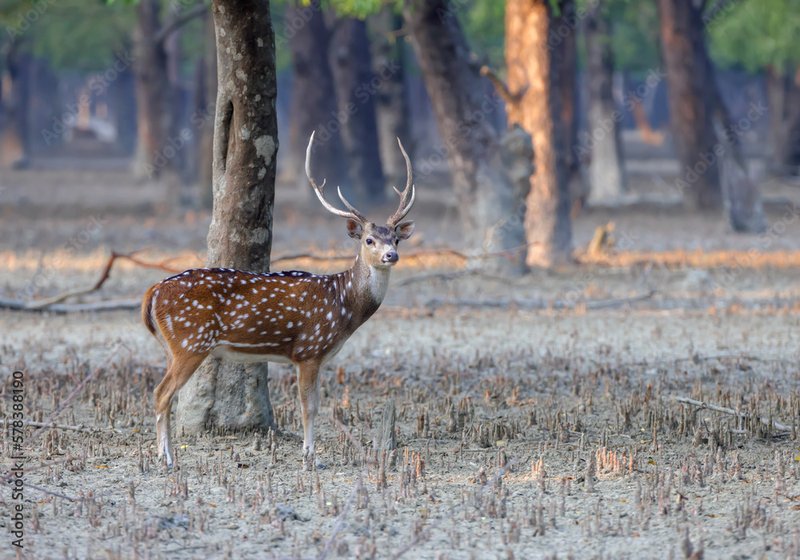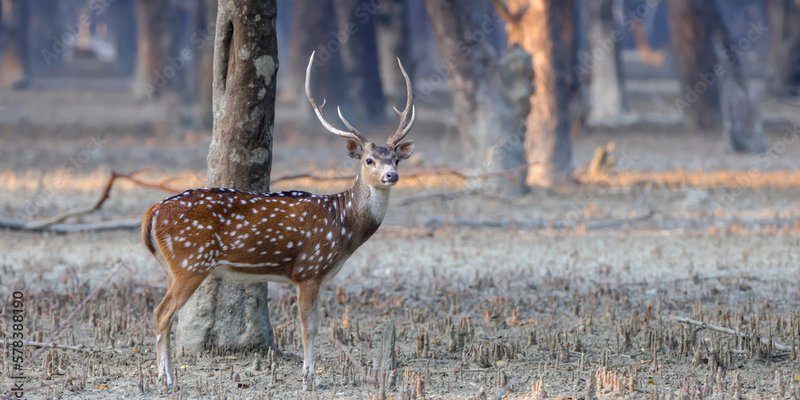
Have you ever seen a deer with spots that look like they belong on a painter’s canvas? That’s the Chital, also known as the spotted deer. These charming creatures are a familiar sight in many parts of India, and they add a touch of elegance to the landscapes they inhabit. With their beautiful coat and graceful movements, they seem almost like nature’s artwork come to life.
Chitals are not just pretty faces; they play important roles in their ecosystem. These deer are vital for the health of their habitats, helping to maintain the balance of plant life by grazing. Besides, they are a favorite subject for wildlife photographers and nature enthusiasts alike. Let’s dive deeper into what makes Chitals so unique and lovable.
Physical Characteristics
The Chital is easily recognizable due to its distinctive coat. They have a reddish-brown fur adorned with white spots that become more pronounced as they mature. Adult males can weigh up to 150 pounds and stand about 3 feet tall at the shoulder, while females are slightly smaller. One of the most striking features of the male Chital is their large antlers, which can span up to 3 feet when fully grown. These antlers are used during the mating season to compete for female attention, showcasing their strength and dominance.
In addition to their size and coloration, Chitals have large, expressive eyes and slender legs built for speed. They can run up to 50 miles per hour when threatened, and their nimble bodies allow them to maneuver gracefully through dense vegetation. Interestingly, their keen eyesight and excellent sense of smell help them detect predators from a distance, giving them a slight edge in survival.
Another fascinating aspect of Chitals is their seasonal coat changes. During the summer months, their fur may appear brighter and more vibrant, while in winter, it can take on a duller hue. This adaptation might help them blend into their surroundings better during different seasons, keeping them safe from predators.
Habitat and Distribution
Chitals thrive in a variety of habitats across the Indian subcontinent, including grasslands, open forests, and even some semi-desert areas. They are particularly fond of regions with lots of undergrowth and shrubbery, as these provide both food and shelter. Their distribution ranges from the foothills of the Himalayas to the tropical jungles of southern India, showcasing their ability to adapt to different environments.
These deer are often found in herds, which can range in size from a few individuals to over a hundred. Living in groups not only offers protection from predators but also ensures that they can easily spot threats from a distance. In wet seasons, Chitals tend to congregate near water bodies, making these areas prime spots for wildlife enthusiasts looking to catch a glimpse of these agile creatures.
Another noteworthy point is their preference for areas close to human habitation. This is something you might find surprising, but Chitals often adapt well to environments altered by humans. They are known to frequent areas near farms and villages where food is plentiful, which can sometimes lead to conflicts between humans and wildlife.
Diet and Feeding Behavior
The diet of a Chital is quite diverse, consisting mainly of grasses, leaves, fruits, and flowers. They are herbivores, and their grazing habits play a crucial role in the health of their ecosystems. By consuming a variety of plants, they help control vegetation growth, allowing new plants to thrive and ensuring that the habitat remains healthy.
You might be interested to know that Chitals have a unique feeding behavior. They often feed in the early morning or late afternoon when it’s cooler, avoiding the harsh midday sun. This not only helps them conserve energy but also reduces the risk of encountering predators. Additionally, they are known to be choosy eaters; they tend to select certain plants based on their nutritional value. This selective grazing helps maintain the balance of plant species in their habitat.
Chitals also exhibit a fascinating behavior called “rumination.” After consuming their food, they often retreat to a safe area to rest and chew their cud—an essential part of their digestion process. This not only allows them to extract maximum nutrients from their food but also keeps them alert to potential threats while they are eating.
Breeding and Social Structure
The mating season for Chitals typically occurs during the monsoon months, which provides ample food and resources for raising young. During this time, males engage in a captivating display of strength, using their antlers to fight other males in bids for dominance. The winner earns the right to mate with several females, which ensures the continuation of his genetic line. It’s like a natural competition where only the strongest and fittest are rewarded.
Female Chitals, called does, usually give birth to a single fawn after a gestation period of about seven months. Interestingly, fawns are born with spots that help them blend in with their surroundings, making them less visible to predators. For the first few weeks, the mother will often hide her young in thick grass, returning only to nurse them. It’s a protective strategy that enhances the fawn’s chances of survival during its vulnerable early days.
Chitals are social animals and often seen in groups. These herds can be mixed-sex, allowing young bucks to learn important social cues from both males and females. Living in groups provides safety in numbers, as they can alert each other to the presence of predators. The bonds formed within these herds are essential for their survival, as they help support each other in various aspects of life.
Conservation Status
Chitals currently face various threats, primarily due to habitat loss and poaching. As human populations expand, many natural habitats are being converted into agricultural land or urban areas, putting pressure on these graceful animals. Additionally, poaching for meat and antlers remains a significant threat, especially in regions where Chitals are less protected.
Organizations and governments are making concerted efforts to protect Chital populations by establishing national parks and reserves. For example, famous national parks like Bandhavgarh and Kaziranga in India serve as strongholds for these deer, providing them with safe habitats where they can thrive. Conservationists are also working on educating local communities about the importance of Chitals and their role in the ecosystem, aiming to foster a sense of stewardship and protect these beautiful animals.
On a hopeful note, Chital populations in certain areas have shown signs of recovery due to these conservation efforts. By raising awareness and implementing protective measures, we can ensure that future generations will continue to enjoy the sight of these magnificent deer in their natural habitats.
Interesting Facts About Chital
| Scientific Name: | Axis axis |
| Average Lifespan: | 10-15 years in the wild |
| Size: | 3-3.5 feet tall at the shoulder |
| Weight: | 75-150 pounds |
| Speed: | Up to 50 miles per hour |
| Habitat: | Grasslands, forests, and near water sources |
| Diet: | Grasses, leaves, fruits, and flowers |
FAQ
What does the name “Chital” mean?
The name “Chital” comes from the Hindi word “chital,” which means spotted deer. This name highlights one of the most noticeable features of these animals—their beautiful spotted coat. This characteristic makes them easily identifiable and admired in their natural habitats.
Are Chitals good swimmers?
Yes, Chitals are surprisingly good swimmers! They often take to the water when they need to escape predators or simply to cool off on a hot day. Their agility in water adds another layer to their survival strategy, allowing them to navigate rivers and wetlands with ease while avoiding danger.
How do Chitals communicate with each other?
Chitals communicate using a variety of vocalizations, including barks and whistles. These sounds help them alert others in their herd of potential dangers. Body language is also crucial; they often use their posture and movements to convey information. For example, a sudden alert stance can signal to others that a predator is nearby.
Do Chital populations migrate?
While Chitals don’t migrate over long distances like some other deer species, they do exhibit seasonal movements. During different times of the year, they may move to areas with more abundant food sources or better cover from predators. These movements are generally localized and depend on seasonal changes in habitat conditions.
What are the main predators of Chital?
Chital faces threats from a variety of predators, including tigers, leopards, and wild dogs. Young fawns are particularly vulnerable and can fall prey to birds of prey as well. Their ability to detect predators quickly and their agility helps improve their survival chances in the wild.
How do Chitals adapt to seasonal changes?
Chitals adapt to seasonal changes primarily through their foraging behavior and coat color. During the rainy season, they will seek out areas with more lush vegetation, while in the dry months, they might congregate near water sources. Their coats become more vibrant in summer and duller in winter, allowing them to blend into their surroundings better during different times of the year.
Are Chitals social animals?
Yes, Chitals are very social creatures. They typically live in herds that can range from a small family group to large gatherings. This social structure helps provide safety from predators and offers support during mating and child-rearing. Living in groups allows Chitals to thrive and maintain their populations effectively.
Can Chitals be domesticated?
Chitals are wild animals and are not suitable for domestication. While they can adapt to habitats impacted by humans, they thrive best in their natural environments. Efforts to domesticate wild deer often lead to stress and poor health for the animals since they are not accustomed to captivity or human management.
How can I help Chital conservation efforts?
You can contribute to Chital conservation by supporting wildlife organizations that focus on habitat preservation and anti-poaching initiatives. Educating yourself and others about the importance of these beautiful creatures is equally vital. Additionally, practicing responsible tourism when visiting national parks can help protect Chital habitats by promoting sustainable travel practices.
What role do Chitals play in their ecosystem?
Chitals play a vital role in their ecosystem as herbivores. By grazing on vegetation, they help maintain plant diversity and promote healthy ecosystems. Their movements can also assist in seed dispersal, as they consume fruits and subsequently excrete the seeds, which can lead to plant growth in new areas, contributing to ecosystem health.

